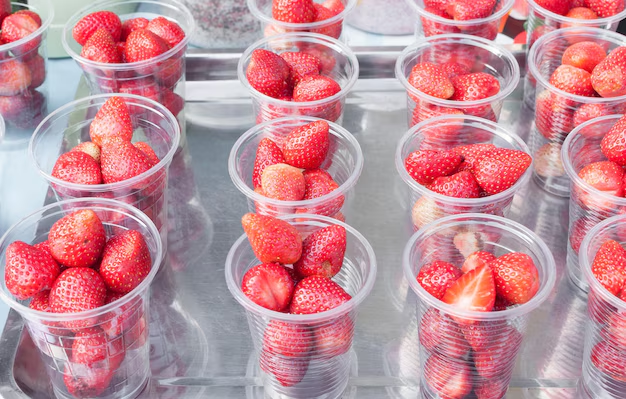How Long Will Your Strawberries Stay Fresh in the Fridge? 🍓
Strawberries are one of the most beloved fruits, celebrated for their sweet flavor, vivid color, and versatility in many culinary creations. But for all their delights, strawberries are also notorious for their fragility. If you’ve ever experienced the disappointment of finding a spoiled pack in your refrigerator, you’re not alone. This guide explores how long strawberries last in the fridge, along with tips and tricks to extend their shelf life.
Understanding Strawberry Shelf Life
When stored properly, strawberries can last approximately 5 to 7 days in the refrigerator. However, several factors can influence this time window, including fruit ripeness, storage conditions, and handling practices.
Factors Affecting Freshness
Ripeness at Purchase: The initial ripeness of strawberries significantly determines how long they will last. Strawberries continue to ripen after being picked, so selecting those that are already quite ripe will reduce their shelf life.
Storage Temperature: Ideally, strawberries should be stored at a constant, cold temperature. Frequent temperature changes can accelerate spoilage.
Humidity Levels: Strawberries prefer a humid environment, which can help slow down the wilting process.
Handling and Washing: Rough handling can bruise the delicate fruit, leading to faster deterioration. Pre-washing is not recommended until you’re ready to consume them, as moisture can encourage mold growth.
Best Practices for Storing Strawberries
To maximize the shelf life of your strawberries, it is vital to store them correctly. Here’s a step-by-step guide to help you out.
Selection at the Grocery Store
- Look for Vibrant Color: Choose strawberries that are bright red with a glossy sheen and fresh green caps.
- Avoid Moldy or Bruised Berries: Inspect the entire container for any signs of mold or damage, as this indicates a shorter lifespan.
Preparing Your Strawberries for Storage
- Keep Them Dry: Moisture accelerates spoilage, so keep your strawberries dry until you are ready to eat or use them.
- Use a Ventilated Container: If possible, repack the strawberries in a container that allows air circulation, such as a colander lined with paper towels.
- Refrigerator Placement: Place the strawberries in the crisper drawer of your fridge, which typically maintains higher humidity levels conducive to berry storage.
Simple Preservation Methods
- Freezing for Long-Term Storage: If you have an abundance of strawberries, freezing them is a practical option. Simply hull the berries, lay them out on a baking sheet for an initial freeze, and then transfer them to an airtight bag.
- Turning into a Preserve or Jam: Another creative way to extend shelf life is to turn excess strawberries into jams or preserves. This not only saves the berries but also brings a delicious homemade touch to your pantry.
Spotting Spoilage: Signs Your Strawberries Have Gone Bad
Sometimes, even with the best care, strawberries can still spoil. Here are key indicators that your fruit may no longer be fresh:
Mold Growth: Mold appears as white, blue, or green spots, often accompanied by a fuzzy texture.
Off Odors: A sour or fermented smell indicates overripe or spoiling fruit.
Texture Changes: Strawberries that become soft, mushy, or have shriveled areas are past their prime.
A Quick List of Storage Tips 🍓
- 🛒 Choose vibrant, firm berries with fresh green tops.
- ❌ Avoid washing until ready to eat.
- 📦 Store in a ventilated container with paper towels.
- 🥶 Freeze if overabundant to prevent waste.
Related Subtopics in Food Preservation
Understanding how strawberries last in the refrigerator opens the door to exploring broader food storage strategies. These strategies not only extend the life of strawberries but can be applied to other produce as well.
The Role of Temperature and Humidity in Food Storage
Proper refrigerator settings can have a dramatic impact on food longevity. For most fruits and vegetables, maintaining a consistent, cool temperature with moderate humidity helps prevent spoilage.
Tips for Optimal Fridge Organization
- Separate Ethylene Producers: Some fruits, such as apples and bananas, emit ethylene gas, which can speed ripening and spoilage in sensitive produce like strawberries.
- Routine Checks: Regularly inspect your refrigerator's contents to ensure that mold or spoiled food doesn't contaminate fresh items.
Exploring Alternative Preservation Methods
For culinary enthusiasts, preserving food can be both a practical and creative endeavor that extends beyond traditional storage.
- Drying and Dehydrating: Remove moisture to prolong shelf life, especially handy for snacks or hiking food.
- Fermentation: This ancient practice adds a unique taste profile while preserving food items.
By leveraging these methods, you can make the most of your produce, decrease waste, and enjoy your beloved strawberries longer.
Crafting Delight From Avoidable Waste
Reducing food spoilage is not only about maximizing the utility of strawberries but also about contributing to a more sustainable lifestyle. Small habit changes—like proper storage techniques or embracing preservation practices—can keep food fresher for longer, reducing waste and enhancing kitchen creativity.
At the end of the day, understanding how long strawberries last in the refrigerator and taking steps to extend their freshness can make a significant difference in both flavor and sustainability. By choosing and storing your strawberries wisely, you ensure a supply of delicious, ripe fruit ready to enjoy at a moment's notice. Whether snacking fresh, creating a balanced smoothie, or incorporating strawberries into your favorite dishes, these vibrant berries will deliver pleasure time and time again.
